| Listing 1 - 10 of 18 | << page >> |
Sort by
|
Dissertation

ISBN: 9789460181832 Year: 2010
Abstract | Keywords | Export | Availability | Bookmark
 Loading...
Loading...Choose an application
- Reference Manager
- EndNote
- RefWorks (Direct export to RefWorks)
Academic collection --- 66.08 --- Physical and physicochemical processes --- Theses --- 66.08 Physical and physicochemical processes
Book
ISBN: 2919969854 Year: 2003 Publisher: Luxembourg Arcelor
Abstract | Keywords | Export | Availability | Bookmark
 Loading...
Loading...Choose an application
- Reference Manager
- EndNote
- RefWorks (Direct export to RefWorks)
66.08 --- Physical and physicochemical processes --- 66.08 Physical and physicochemical processes --- Galvanisation --- Histoire.
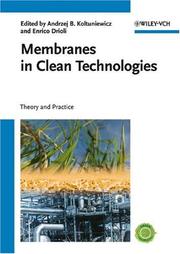
ISBN: 9783527320073 3527320075 Year: 2008 Publisher: Weinheim Wiley-VCH
Abstract | Keywords | Export | Availability | Bookmark
 Loading...
Loading...Choose an application
- Reference Manager
- EndNote
- RefWorks (Direct export to RefWorks)
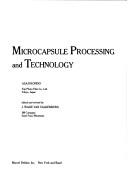
ISBN: 0824768574 9780824768577 Year: 1979 Publisher: New York Dekker
Abstract | Keywords | Export | Availability | Bookmark
 Loading...
Loading...Choose an application
- Reference Manager
- EndNote
- RefWorks (Direct export to RefWorks)
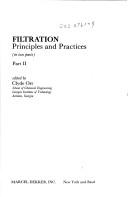
ISBN: 0824762835 0824767632 Year: 1979 Publisher: New York (N.Y.) Dekker
Abstract | Keywords | Export | Availability | Bookmark
 Loading...
Loading...Choose an application
- Reference Manager
- EndNote
- RefWorks (Direct export to RefWorks)
Book
ISBN: 9783527320387 Year: 2009 Publisher: Wiley
Abstract | Keywords | Export | Availability | Bookmark
 Loading...
Loading...Choose an application
- Reference Manager
- EndNote
- RefWorks (Direct export to RefWorks)
The only book dedicated to membrane technology, covering all the different innovative membrane areas from separation to contactors, and regarding them as unit operations in process engineering. The specific potential of these advanced new operations is analyzed by different experts in the field, with regard to their basic aspects and in particular to their potential application for a sustainable growth and improvement in the quality of life. To this end, much emphasis is placed on the role of membrane engineering as a dominant technology in such areas as water desalination or artificial organs. The editors are well known and recognized within the community, while the active experience of the authors provides a highly practical, industrially relevant approach to the subject. Topics considered in detail include membranes in fuel cells, membranes in MEMS and OLEDS, as well as integrated membrane systems.
Macromolecules --- General biochemistry --- Water supply. Water treatment. Water pollution --- biochemistry --- polymers --- solvent --- biomembranen --- biochemie --- afvalwater --- polymeren --- 66.08 --- 66.08 Physical and physicochemical processes --- Physical and physicochemical processes
Dissertation
ISBN: 9789460187940 Year: 2015 Publisher: Leuven KU Leuven. Faculteit ingenieurswetenschappen
Abstract | Keywords | Export | Availability | Bookmark
 Loading...
Loading...Choose an application
- Reference Manager
- EndNote
- RefWorks (Direct export to RefWorks)
In recent years the application of membrane technology to molecular separation processes has stimulated interest and showed great potential in a number of industrial fields. A new membrane market is arising in the chemical industry where many in-process separation problems can be tackled elegantly by sufficiently stable membranes. Since the 1990s progress has also been made in the development of solvent resistant nanofiltration membranes, opening the possibility to tackle several separation problems in non-aqueous solvents. Organic solvent nanofiltration (OSN) offers great perspectives towards wide application in the process industry as it provides a facile, energy-efficient and scalable alternative to conventional separation processes such as distillation, liquid-liquid extraction or chromatographic purification. It has been proven that OSN has an enormous potential innbsp;solvent intensive pharmaceutical and fine-chemical processes, where it can be used for the recovery, concentration and purification of valuable target molecules, as well as for the purification and recycling of spent solvents. Here, ceramic nanofiltration membranes with their broad solvent resistance and high temperature stability,nbsp;the potential to take a significant market share.The state-of-the-art nanoporous ceramic membranes for OSN are transition metal oxide membranes, containing a large amount of surface OH-groups, making them strongly hydrophilic. By exchanging these hydroxyl groups by a more apolar group (such as alkyl, perfluoroalkyl,...), the surface becomes more hydrophobic, increasing non-polar solvent fluxes. Recently, VITO and UA have developed a new versatile grafting method (modification with Grignard reagents) capable of attaching a direct, non-hydrolysablenbsp;between the membrane surface and the functional group. This results in novel membranes with a wide range of surface functionalities.The approach used in this thesis is to investigate the properties, performance and potential of these grafted membranes in organic solvent nanofiltration. The properties of the Grignard modified membranes were examined by physico – chemical characterisation (contact angle measurements, micro-ATR/FTIR-spectroscopy) in addition to performance characterisation (flux and retention measurements). All observations for modified membranes are consistent with the assumed partial replacement of the OH-groups on the membrane surface and the consequent amphiphilic character of the modified membrane surface. Moreover, the solvent filtration performance and application potential of such Grignard functionalised membranes was further evaluated and explored. To this purpose, the retention behavior of a variety of 5 different model solvent/solute mixtures was determined for a variety of grafted and ungrafted membranes. The varying retention behaviour was evaluated by considering thenbsp;affinity of solvents and solutes for the modified and unmodified membrane surfaces. To support this interpretation, a sorption test was used to quantify the solute-membrane affinity. A long-term test was performed in order to check the stability of grafted groups on the surface of the membrane.Further experimental work was directed to understand how to tune solvent-membrane-solute interactions in a controlled way in order to enhance OSN performance.nbsp;was achieved by performing an extensive retention study on two type of Grignard functionalised membranes, choosing three PEG molecules and polystyrene as solutes, all with almost the same size but different polarities, in a wide range of solvents including water, ethanol, dimethylformamide (DMF), isopropanol, acetone, dichloromethane (DCM), tetrahydrofuran (THF), methyl ethyl ketone (MEK), toluene, ethyl acetate, methyl isobutyl ketone, cyclohexane and methyl cyclohexane. To unravel the transport mechanism properly, the pressure effect of fluxnbsp;retentions was thoroughly investigated. The retention results showed in general a very different behaviour in different ranges ofnbsp;at low solvent polarity, retentions are relativelynbsp;varying with pressure and solvent polarity; at high solvent polarity, retentions are relatively high, and independent of pressure and solvent polarity. The Spiegler-Kedem theory, taking into accountnbsp;diffusion and convection transport mechanisms, was used as a basis for a fundamental explanation of the results and explaining the competing contribution of diffusion and convection in solute transport. Finally, this study demonstrates the importance of all solvent-membrane-solute interactions in the OSN transport, but also shows how theynbsp;be manipulated to enhance the membrane performance.
academic collection --- 66.08 <043> --- Physical and physicochemical processes--dissertations --- Theses --- Academic collection
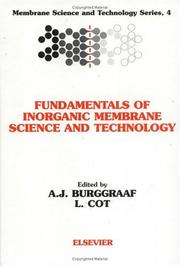
ISBN: 0444818774 9780444818775 9780080534701 0080534708 1281047465 9781281047465 9786611047467 6611047468 Year: 1996 Volume: 4 Publisher: Amsterdam Elsevier
Abstract | Keywords | Export | Availability | Bookmark
 Loading...
Loading...Choose an application
- Reference Manager
- EndNote
- RefWorks (Direct export to RefWorks)
Inorganic membrane science and technology is a new field of membrane separation technology which until recently was dominated by the earlier field of polymer membranes. Currently the subject is undergoing rapid development and innovation. The present book describes the fundamental principles of both synthesis of inorganic membranes and membrane supports and also the associated phenomena of transport and separation in a semi-quantitative form. Features of this book: - Examples are given which illustrate the state-of-the-art in the synthesis of membranes with controlled properties
Surface chemistry --- Chemical technology --- fysicochemie --- Membranes (Technology) --- 66.08 --- 66.08 Physical and physicochemical processes --- Physical and physicochemical processes --- Artificial membranes --- Separation (Technology) --- Technology --- Inorganic compounds. --- Compounds, Inorganic --- Inorganic chemicals --- Chemicals --- Chemistry, Inorganic
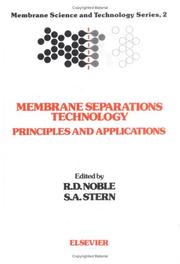
ISBN: 044481633X 9780444816337 9786611034573 1281034576 0080536182 9780080536187 Year: 1995 Volume: 2 Publisher: Amsterdam ; New York : Elsevier,
Abstract | Keywords | Export | Availability | Bookmark
 Loading...
Loading...Choose an application
- Reference Manager
- EndNote
- RefWorks (Direct export to RefWorks)
The field of membrane separation technology is presently in a state of rapid growth and innovation. Many different membrane separation processes have been developed during the past half century and new processes are constantly emerging from academic, industrial, and governmental laboratories. While new membrane separation processes are being conceived with remarkable frequency, existing processes are also being constantly improved in order to enhance their economic competitiveness. Significant improvements are currently being made in many aspects of membrane separation technology: in the devel
Membrane separation --- 66.08 --- 66.08 Physical and physicochemical processes --- Physical and physicochemical processes --- Filtration, Membrane --- Membrane filtration --- Separation, Membrane --- Separation (Technology) --- Membrane separation technologies --- MEMBRANES --- Monograph --- Membrane separation. --- Membranes (Technology) --- Artificial membranes --- Technology
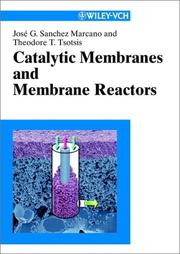
ISBN: 3527302778 Year: 2002 Publisher: Weinheim Wiley-VCH
Abstract | Keywords | Export | Availability | Bookmark
 Loading...
Loading...Choose an application
- Reference Manager
- EndNote
- RefWorks (Direct export to RefWorks)
Catalysts --- Membrane reactors --- 66.08 --- Catalytic agents --- Catalysis --- Chemical inhibitors --- Reactors, Membrane --- Bioreactors --- Membranes (Technology) --- 66.08 Physical and physicochemical processes --- Physical and physicochemical processes --- Fysicochemical separation methods --- Materials sciences --- Biotechnology --- bioengineering --- reactoren (chemische technologie) --- membranen (chemische technologie) --- biotechnologie
| Listing 1 - 10 of 18 | << page >> |
Sort by
|

 Search
Search Feedback
Feedback About UniCat
About UniCat  Help
Help News
News